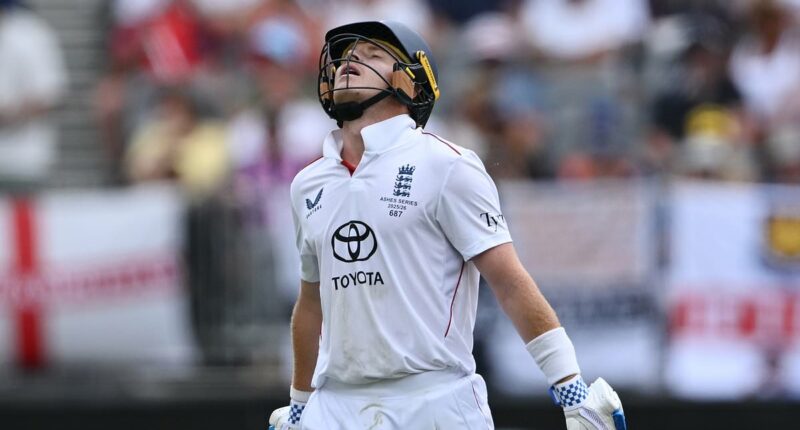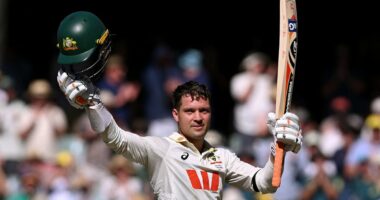Share this @internewscast.com
The tide turned dramatically in an hour that not only altered the direction of the match but might have set the tone for the entire series. This pivotal moment also cast doubt on England’s capability to rectify their mistakes quickly enough to be competitive in the Ashes.
At 65 for one after lunch on the second day of the first Test, England held a commanding lead of 105 runs, seemingly in control against Australia. Yet, in a shocking turn of events, they crumbled to 88 for six, desperately clinging on.
Less than five and a half hours later, England was left reeling from an eight-wicket loss, having been thoroughly outplayed by Travis Head. Head’s explosive innings, which included a blistering century off just 69 balls, left England shell-shocked.
While England has experienced setbacks before, none have been as crushing or marked by such a swift change in fortune. It had been over a century since an Ashes Test concluded in just two days, and not since 1904 had England been bowled out twice in a Test with such brevity, lasting only 67.3 overs.
Supporters who traveled great distances to cheer for their team and spent Friday night reveling in Perth’s lively bars were met with a defeat of monumental scale. The pressing question remains: how did it all unravel?
The unraveling commenced when Ben Duckett found himself caught at second slip off Scott Boland’s delivery. This dismissal came despite Duckett’s earlier success in unsettling Boland’s line during the first innings.

Scott Boland celebrates claiming the prized scalp of Harry Brook to set Australia on their way

Brook fell for a three-ball duck on a day that went from bad to worse for England, who are now 1-0 down in the series
It wasn’t an especially bad shot and, besides, worse was to come. Far worse. At 76 for two, England were still in control, only for Ollie Pope to edge one of the many drives he had aimed unsuccessfully at Boland.
It was a wasteful way to go for a player who had missed a leg-stump half-volley in the first innings after battling to 46, and had now done the hard yards again en route to 33. Senior players ought to know how to cash in. Pope flunked the test twice.
Out walked Harry Brook, whose first-innings half-century remained the knock of the match until Head eclipsed him as Australia raced to their target of 205 inside 29 overs. Now, though, he declined to reacquaint himself with the conditions, aiming a loose drive on the up at his third ball and picking out Usman Khawaja in the slips.
And Australian joy was unconfined when Joe Root, having avoided the ignominy of a pair, chopped Starc on to his stumps as he played with the kind of crooked bat that is supposed to be banned on the bouncier pitches in this part of the world.
Three wickets in six balls, and the cream of England’s middle order gone, just like that – all to strokes that come with warning signs in Australian conditions.
Stokes, in fairness, got another good delivery from the rampant Starc, completing an hour from hell that left England 88 for six, and persuaded Australia this game was theirs for the taking.

Joe Root endured a quiet Test, falling for a duck in the first innings before he chopped on against Starc on eight in the second

Mitchell Starc cleaned Ben Stokes up with a beauty in the second innings
Later, Stokes insisted that the players who had chanced their arm by trying to hit the bowlers off their most dangerous length were the ones who succeeded: Brook on Friday, Head on Saturday.
But, to pull that off, you need to possess either Brook’s remarkable hand-eye coordination, or Head’s counter-attacking nous and familiarity with the conditions. And, for all Root’s class, the rest of England’s line-up have neither.
If the message from Stokes and Brendon McCullum is that England must recommit to their hard-hitting principles, even on pitches that have more life in them than anything they play on at home, then we could be in for a long tour. Or a short one, depending on how you look at it.
Amid the dissection of England’s middle order, it was easy to overlook the fact that Zak Crawley had twice fallen for a duck in the opening over to Starc, completing the first pair by an England opener since Mike Atherton in Johannesburg 26 years ago.
So low are the expectations of a player whose standing in the dressing-room often seems in inverse proportion to his reputation among the public, that no one batted an eyelid – except to admire Starc’s brilliantly athletic return catch from the fifth ball of England’s second innings after Crawley prodded at one for no obvious reason other than the desire to feel bat on ball.
England will stick with him, despite his increasingly untenable Test average of 31. And in so doing they will hand a gift to critics who regard the management’s loyalty to their opener as symptomatic of a wider malaise, one in which the Bazballers’ heads remain in the sand, impervious to reality.

Zak Crawley’s place in the team will come under even more scrutiny after he recorded a pair in the opening Test

The England captain has plenty to mull over ahead of the second Test following his side’s disastrous collapse
That would overstate the case. Their demolition of Australia’s first innings offered genuine optimism that England’s coterie of fast bowlers can make a series of it, and at lunch on the second day there was only one team in this Test.
But the surrender that followed reopened old scars, and hinted at a refusal to adapt to circumstance – precisely the charge that dogged this team when they lost the Ashes Test at Lord’s in 2023 amid a flurry of harebrained hooks.
It is a tricky balance, no doubt. England can’t suddenly dispense with the attitude that has informed the past three and a half years under Stokes and McCullum. Then again, if the definition of madness really is repeating the same mistake and expecting a different outcome, the meltdown on the second and final afternoon in Perth felt like Exhibit A.
With four Tests still to come, England have time to turn things around. Whether they have the inclination is another matter altogether.












